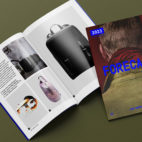Maker Series :: Tailfeather
Tailfeather have built up a solid reputation through their elegant, durable and minimalist carry pieces. But the Australian carry brand wouldn’t be where it is today without the dedication and passion of its founders, husband and wife team Scottie and Natalia. Based on Victoria’s Bellarine Peninsula, they craft Tailfeather’s handsome and practical pieces by hand, along with a small team of skilled local craftspeople. Below Scottie shares Tailfeather’s creative journey and his insights as a maker who never stops learning…
How does your brand/process speak to the notions of “craft?”
To me, craft is learning knowledge and skills from your own ideas, success and errors. It’s a never-ending process, you control your own level of progress by how much you put into it. This is exactly what TF is to me, a platform to teach myself and share my work with others.
What are your tools of the trade?
We use basic leather tools; knives, punches, blades, clamps and jigs. We’ve also modified and built a few of our tools to suit our needs.
For our canvas sewing we have 3 Pfaff sewing machines 1245, 1246, 335. We also use an electric skiver, a converted Raleigh kick press and a laser engraver.
What spurred you to make stuff? Tell us the story.
I’ve always made stuff, sewn a few garments and enjoyed making patterns from scratch.
While travelling through South America and Asia in 2008 I found myself intrigued by leather craftsmen and shoemakers wherever I went. I guess it was the first time I had really been exposed to leather craft.
In 2009 I was searching for leather saddlebags for my Triumph Bonneville motorbike. Unhappy with what was available I decided to make some myself.
After completing my first leather pouch as a test piece, I went to Natalia (my wife and business partner) and asked if she wanted to start a leather goods label. It wasn’t really a question as my mind had raced ahead and I registered the business name and domain and finished the logo within two days of starting my first leather piece.
For the next 12 months we invested in tools and materials and worked on developing skills and techniques; cutting, sewing and pattern making before launching our first pouches, satchels, card holders and iPhone cases.
Our pieces received a great response wherever we went with them. This gave us great confidence to continue.
“To me, craft is learning knowledge and skills from your own ideas, success and errors. It’s a never-ending process, you control your own level of progress by how much you put into it.”
What keeps you excited about making stuff?
Seeing people using and enjoying our products. It’s great to have people come in to the store and tell us about their TF item, how long they’ve had it and how much they love using it.
Also.
Each time I work on new samples or start production on a new product, I learn so much. Whether it is a new way to do a corner, or finishing technique, an idea for a new piece of hardware or even a new piece of workshop equipment. It always keeps you thinking.
Seeing an idea become a tangible, practical and sellable object is really addictive.
One handy tip or learning gleaned along your journey?
If you have an idea, work on it; don’t put it off because it’s not “complete” or “good enough”. The more pieces you finish, the quicker you learn and the easier the ideas come.
“Each time I work on new samples or start production on a new product, I learn so much.”
Walk us through your creative process…
I constantly keep sketches and notes on ideas. I use TF items on a daily basis and work on the ones that I think can be improved on. It could be the entire bag or just sections of it.
After my initial idea for a silhouette, I do some sketches and then sit on them for a few weeks before I start the pattern. I tend to start to think about the piece in pattern form and will go through a few of the options before I start the pattern.
I usually spend about 10-12 hours on the first pattern. Once I finish the first sample I make the necessary changes, which can be either a few small tweaks or a complete re-start.
What other makers inspire you?
I love watching people build anything. I spend a lot of time watching YouTube videos of motorcycle builds and homemade campervans.
“If you have an idea, work on it; don’t put it off because it’s not “complete” or “good enough”. The more pieces you finish, the quicker you learn and the easier the ideas come.”
What’s your all-time favorite TF piece? What keeps filling you with pride?
I like the early ones, like the original Wanderer backpack because it showed our depth in design and making. It proved to us that we could produce to the level that we envisioned.
What lies ahead for the “maker movement?”
Makers can only continue if people support the craft and appreciate the process required to create.
Traditional handmade craft even with modern technology runs at a high raw materials cost to begin with. Add local labor to the mix and we can sometimes see very little return.
We hope that the local maker movement continues to grow.





 Carry Awards
Carry Awards Insights
Insights Liking
Liking Projects
Projects Interviews
Interviews

















